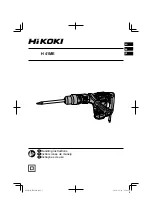
Manual TL135 English rev1
Page 1 of 3
POWER SUPPLY TL 135
Installation Manual
FUNCTIONS
The power supply is made of: one linear power supply, with serial voltage regulator, limited in constant precision current (r ectangular
limitation); one analogical control circuit and one microcontroller supervision circuit.
Supplying is shared out among four outputs, on terminals protected by corresponding fuses:
BAT: where the back-up battery will be connected OUT1, OUT2 and OUT3: for general charges
The charge of the battery occurs at constant voltage (13,8 Vdc @ 25°C) with limited current.
Leds in the control board (see Pict. 1) show:
Cut fuse for any of the outputs, with Led off (DL9, DL10, DL11)
Current consumption by the charge (2 green and 1 red, DL5, DL6, DL7)
Mains presence (DL1 RETE)
Failures (DL2)
Control of battery efficiency.
The power supply periodically controls the batteries efficiency:
-
At first power supply activation, the microprocessor carries out the test of battery presence after 30 seconds. If battery is
connected, the test will be carried out periodically every 10 minutes whilst, if not connected, it will continue carrying out the
test every 20 seconds, showing the anomaly with DL2. This anomaly will be kept in memory until a battery is connected.
-
During standard operating, the battery efficiency is checked watching batteries voltage. If batteries do not manage to
maintain an acceptable voltage during test, there will be activation of DL2.
-
In case of missing mains, if the battery voltage is lower than 9,5Vdc, the battery and the charge are disconnected in order
to avoid malfunctioning of the system and to avoid deep discharge of the battery. The battery will be reconnected in case it
is replaced or in case of mains restore.
-
During standard operating, a test of the battery internal resistance is carried out every 90 minutes; if the internal resistance
happens to be over 1 ohm, there will be on of DL2. It will then be necessary to replace the battery and check that terminals
and fuses have a good electrical contact. When the battery is replaced, having mains presence, the test of the internal
resistance is repeated within 5 minutes.
In order to avoid a possible failure damaging the charges or the battery, a protection circuit against over-voltages has been inserted,
made by a SCR and a fuse. There also is a fuse for alternated mains supplying. In case of failure in the power supply or of mains
absence, the battery will supply the electronic circuits.
Chart. 1
ELECTRICAL SPECIFICATIONS
Supplying voltage
230 Vac + 10% / - 15%
AC mains frequency
50 Hz sinusoidal
Current consumption from the mains
0,5 A max (at full charge)
Output voltage
13,8 Vdc (-15% / + 10%)
Minimum output voltage
9,5 Vdc at max charge, in mains absence and with discharged
battery
Voltage of switching-off threshold
9,5 Vdc
Max current consumption
5 A
Adjustment towards mains variations at full charge (+10% / -
15%)
Better than 1%
Adjustment towards charge variations (0 to 100%)
Better than 1%
Residual ondulation (ripple) at full charge
1Vpp (at 195,5 Vac) 30m Vpp (at 253 Vac)
Protection against inversion of battery polarity
Diodes
Alarm threshold of the battery internal resistance
1 ohm
Tension of intervention of the protection from overtensions
18Vdc
Dry-contact relay output for mains absence and failure
25 Vac or 60Vdc 1A max
Chart. 2
MECHANICAL SPECIFICATIONS
Size in mm.
Height 99; length 232; depth 183
Weight
3,1 Kilos
Chart. 3
ENVIRONMENTAL SPECIFICATIONS
Operating temperature
From
– 10°C to +40°C
Humidity
From 5% to 93% ±2%
Cooling
For convection
Installation site
In repaired position
Chart. 4
FUSES
F1
Fuse of the 230 Vac supplying input (T2 AL 250V)
F5
Fuse related to output OUT 2 (T3,15 AL 250V)
F3
Battery fuse (T6,3 AL 250V)
F6
Fuse related to output OUT3 (T3,15 AL 250V)
F4
Fuse related to output OUT 1 (T3,15 AL 250V)
F8
Fuse of protection over-voltage (T6,3 AL 250V)





















